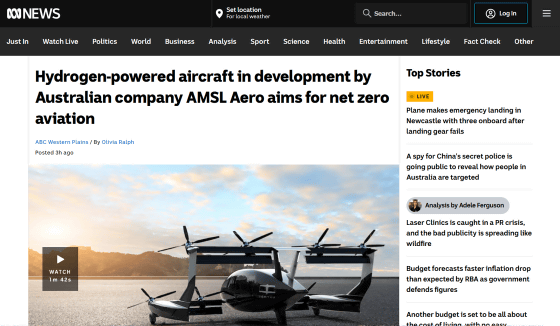Testing of hydrogen-powered electric aircraft 'Vertiia' is underway and it could begin operation in 2027

As stopping climate change is considered an urgent task for the earth and humanity, the share of environmentally friendly electric vehicles is increasing, but the aviation industry has been slow to transition from fossil fuels to electricity. Meanwhile,
Hydrogen-powered aircraft in development by Australian company AMSL Aero aims for net zero aviation - ABC News
https://www.abc.net.au/news/2024-05-13/hydrogen-electric-powered-aviation-net-zero-target/103728122

To stop climate change, it is important to move away from fossil fuels, so the aviation industry, like the automotive industry, is exploring electrification. However, because aircraft are large and heavy, existing battery technology limits even the smallest aircraft to flying distances of just over 200 km.
Meanwhile, AMSL Aero, a startup that aims to 'decarbonize air travel,' is developing the Vertiia, an electric aircraft that can carry up to five people, claiming that it can extend the range of small aircraft to 1,000 km by using hydrogen fuel cells as a power source.
Air Link , a regional airline based in New South Wales, Australia, has already placed a commercial order for the Vertiia with AMSL Aero. Air Link CEO Matthew Klein said the deal is key to achieving the industry's plan to achieve zero carbon emissions by 2050. 'The use of hydrogen is a game changer for us. Being able to achieve a range of up to 1000km is what we need for our work,' he said.
The Vertiia is the first Australian-made aircraft to apply for Advanced Air Mobility (AAM) type certification through the Australian Civil Aviation Safety Authority (CASA) . Given that the Vertiia has characteristics of both a helicopter and a fixed-wing aircraft, obtaining certification is an exciting but daunting task. 'No one has done this in Australia before, so in that sense it's breaking new ground,' said Klaus Schwerdtfeger, CASA's manager of aircraft certification.

While companies around the world are working to improve the fuel efficiency of existing aircraft, AMSL Aero has chosen to develop an electric aircraft using hydrogen fuel cells from scratch. 'Other companies are converting fixed-wing aircraft or helicopters, but Vertiia is starting from scratch,' said Siobhan Lyndon, co-founder of AMSL Aero.
Vertiia can fly at a cruising altitude of 3,000m using eight motors that rotate horizontally and movable wings that can change tilt.

The main feature of the Vertiia is the movable wings that surround the main body. When designing the special shape of the wings, co-founder and chief engineer Andrew Moore was inspired by the '

'The Vertiia is an evolution of the box kite that Hargrave invented,' Moore said. 'We actually studied a number of configurations and happened to come to the same conclusion as Hargrave: the box wing works really well.'
Testing of Vertiia has already begun on a runway near Wellington in New South Wales, and if regulatory approval is obtained, it could begin operation in 2027. Air Link plans to first introduce Vertiia on cargo and charter flights, and then use it on scheduled flights connecting Dubbo , Walgett , Bourke , Lightning Ridge and other destinations.
'Right now we fly a plane to Bourke, leave it there all day and come back in the afternoon,' Klein said. 'But because the Vertiia is so cheap to run, we can bring it back and do other flights or even make multiple trips in a day.'

Related Posts:
in Ride, Posted by log1h_ik







